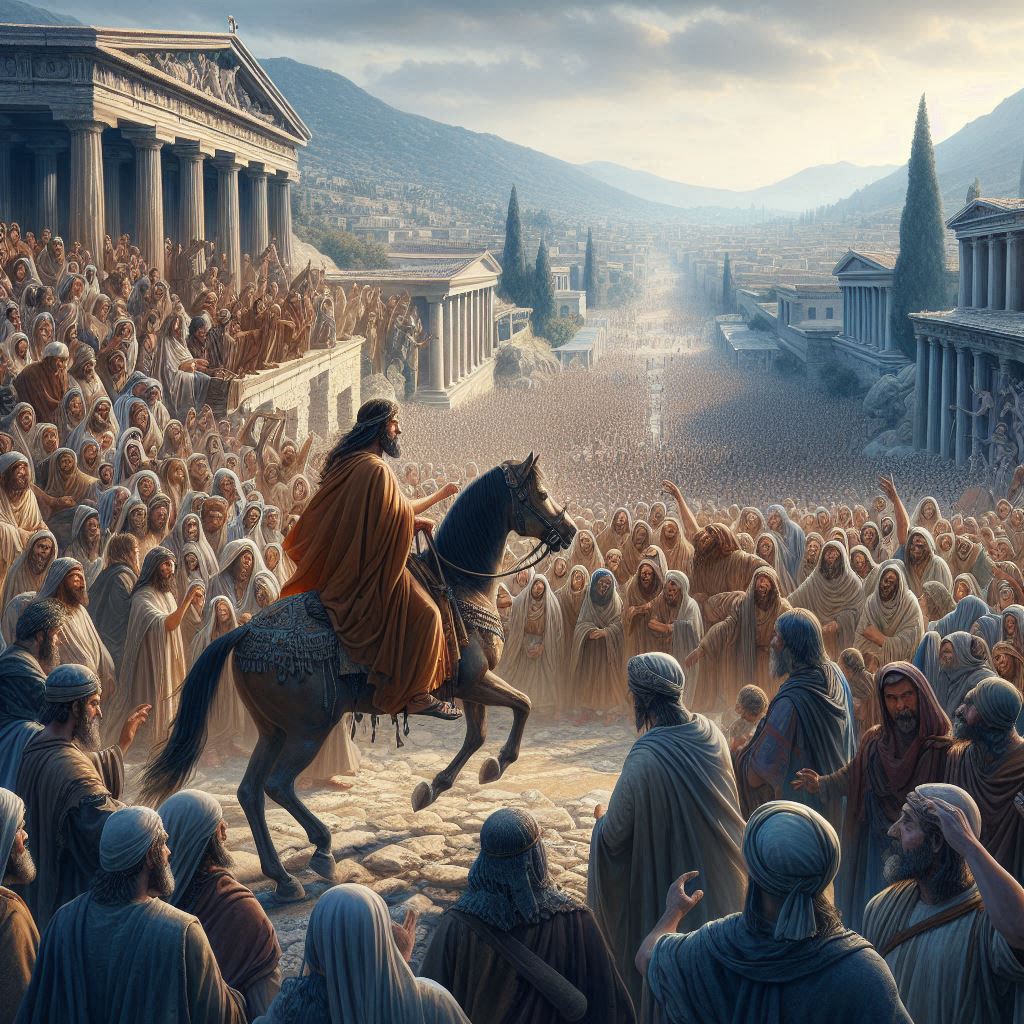Today’s daf continues to address stoning issues, opening with a series of exercises in talmudic logic, which are jarring because of the crass material they are applied to. The mishna posits that people who are stoned to death are hung later, and we are offered two different treatments of this rule. Rabbi Eliezer’s logic: a verse calls for hanging those who curse God (Deuteronomy 21:23) and, since the punishment for blasphemy is stoning, it follows that those who are stoned are later hung. Other rabbis’ logic: The blasphemer denies the principle of belief, and as such is hung, but people who have not denied the principle of belief are not hung after their execution.
This disagreement is an opportunity for understanding logical principles: The rabbis used a principle called כְּלָלֵי וּפְרָטֵי, generalization and distinction, whereas Rabbi Eliezer relied on the principle of רִיבּוּיֵי וּמִיעוּטֵי, amplifications and restrictions. For the rabbis, the issue of denying the principle is a detail that requires limiting the rule to that specific transgression; for Rabbi Eliezer, however, the distance between the generalization and the detail means that the detail does not apply and therefore all those who are stoned should be hung.
This is followed by other demonstrations of similar interpretive principles on the same issue. For example, the words ״וְתָלִיתָ אֹתוֹ״ (and you shall hang him) is taken by sages to mean that hanging is only for men (him, not her), and by Rabbi Eliezer to mean that the man is to be hung naked (just him, without his clothes). The rabbis agree with Rabbi Eliezer, but derive the idea that women should not be hung from the verse ״וְכִי יִהְיֶה בְאִישׁ חֵטְא״ (and if a man, as opposed to a woman has committed a sin). This leads the sages to debate whether the hanging-after-stoning procedure befits the scenario of a rebellious child (בֵּן סוֹרֵר וּמוֹרֶה).
It’s worth pausing briefly to explain that the issue of the rebellious child, and the atrocious capital punishment the bible has in store for him, is something that bothered generations of biblical exegetes, to the point that it’s been interpreted in absurdly restrictive ways to ensure that no one walks away from reading biblical verse thinking that children should be put to death. So the sages’ conversation about this is purely theoretical, an exercise in logic, even though the raw material they use is beyond disturbing (one has to wonder whether these conversations actually took place, and if so, if they troubled any of the speakers and listeners).
Anyway, back to the rebellious child’s hanging-after-stoning. According to Reish Lakish, that the verse uses the term אִישׁ (man) means that children are to be excluded. But Rabbi Eliezer thinks that the mention of the word חֵטְא (sin) implies that the rebellious child was to be included in the hanged-after-stoning category.
At this point, the page moves on to the question whether a court may pronounce two death sentences on the same day. The sages discuss a supposed historical precedent in which Shimon ben Shatah ordered the hanging of eighty women on the same day, and Rav Hisda explains it away hypertechnically: all the women were executed in the same manner, and thus it was one death sentence (but for multiple people). A more precise restatement of Rav Hisda’s principle is that the announcement of multiple executions is permissible only when the transgression, as well as the mode of execution, are the same (but, remember, for multiple people). This principle, they explain, applies even to people mixed up in the same transgression: adulterers, violators of purity laws, transgressors and perjured witnesses who testified for them.
To the extent that there’s anything to this beyond logic games, I can think of two ideas. The first that announcing capital punishment is something that should be seriously considered, and that the court must focus on each case individually–which means that, even in the context of the same scheme, people’s situation should be individually addressed. The second has to do with the interplay between different people mixed up in the same scheme, whose culpability might not be equal. It is only in cases that seem identical in terms of transgression and punishment that the sages may consider them on the same day (this reminds me a lot of David Sudnow’s “Normal Crimes,” and how quick we are to dispose of cases that appear to be the same and do not present any unusual features).
In any case, here the case shifts to something else: the fact that courts might issue harsh sentences beyond those prescribed in the Torah:
תַּנְיָא, רַבִּי אֱלִיעֶזֶר בֶּן יַעֲקֹב אוֹמֵר: שָׁמַעְתִּי שֶׁבֵּית דִּין מַכִּין וְעוֹנְשִׁין שֶׁלֹּא מִן הַתּוֹרָה, וְלֹא לַעֲבוֹר עַל דִּבְרֵי תוֹרָה, אֶלָּא כְּדֵי לַעֲשׂוֹת סְיָיג לַתּוֹרָה.
It is taught in a baraita: Rabbi Eliezer ben Ya’akov says: I heard that the court may administer lashes and capital punishment, even when not required by Torah law. And they may not administer these punishments with the intention of violating the statement of the Torah, i.e., to disregard the punishment stated in the Torah and administer another punishment; rather, they may administer these punishments to erect a fence around the Torah, so that people will fear sinning.
And we’re given two examples:
וּמַעֲשֶׂה בְּאֶחָד שֶׁרָכַב עַל סוּס בְּשַׁבָּת בִּימֵי יְוָנִים, וֶהֱבִיאוּהוּ לְבֵית דִּין וּסְקָלוּהוּ, לֹא מִפְּנֵי שֶׁרָאוּי לְכָךְ, אֶלָּא שֶׁהַשָּׁעָה צְרִיכָה לְכָךְ.
And an incident occurred involving one who rode a horse on Shabbat during the days of the Greeks, and they brought him to court and stoned him, not because he deserved that punishment, as riding a horse on Shabbat is forbidden only by rabbinic decree, but because the hour required it, as people had become lax in their observance of Shabbat and therefore it became necessary to impose the severe punishment for a relatively minor offense.
Riding a horse on Shabbat became a serious business because it occurred “in the days of the Greeks,” meaning, during the Hellenistic culture wars, which were characterized by religious oppression and ferocious inner strife between adherents and assimilationists.
The other example involves a man who slept with his wife under a fig tree and was flogged, again, לֹא מִפְּנֵי שֶׁרָאוּי לְכָךְ, אֶלָּא שֶׁהַשָּׁעָה צְרִיכָה לְכָךְ: presumably, modesty has become lax and people needed a reminder. The minor transgression reminds me of Durkheim’s “society of saints” example in The Division of Labor in Society:
Imagine a society of saints, a perfect cloister of exemplary individuals. Crimes, [commonly] so called, will there be unknown; but faults which appear venial to the layman will create there the same scandal that the ordinary offense does in ordinary consciousness. If then, this society has the power to judge and punish, it will define these acts as criminal and will treat them as such.
Durkheim and the talmudic sages are aware of the power of enforcement in awakening the collective conscience: any society will have a certain amount of punishment and deviation, because it serves an important social role. When norms become lax, or when there’s an important reason to issue a stern reminder, relatively minor transgressors will be made into examples.
But maybe, following Durkheim, there’s another important role that our Shabbat horseback rider plays–one that the sages did not intend. Durkheim uses the example of the execution of Socrates:
According to Athenian law, Socrates was a criminal and his condemnation was just. However, his crime – his independence of thought – was useful not only for humanity but for his country. It served to prepare a way for a new morality and a new faith, which the Athenians then needed because the traditions by which they had hitherto lived no longer corresponded to the conditions of their existence. Socrates’ case is not an isolated one, for it recurs periodically in history. (1895/1982: 102)
Could it be that our horseback rider is reminding his astonished community that, in Hellenistic times, it is perhaps less important to insist on dogged pursuit of the rules and more important to survive? And could it be that the couple making love under the fig tree are reminding their community that outdoor lovemaking can be great fun and is not a big deal? These are possibilities that the talmudic sages are, understandably, not too interested in pursuing.
The remainder of today’s page deals with the question of burying those who were executed. If, and how, to mourn the condemned is a matter discussed in detail, with the logical effort directed at distinguishing undue honors from keeping propriety and dignity after death. The most poignant part of this discussion is:
וְלֹא הָיוּ מִתְאַבְּלִין, אֲבָל אוֹנְנִין, שֶׁאֵין אֲנִינוּת אֶלָּא בַּלֵּב.
And the relatives of the executed man would not mourn him with the observance of the usual mourning rites, so that his unmourned death would atone for his transgression; but they would grieve over his passing, since grief is felt only in the heart.
This reminded me of the beautiful aria sung by the mother of the condemned in Jake Heggie’s beautiful aria Dead Man Walking:
Tomorrow’s page continues the question of mourning the condemned.

